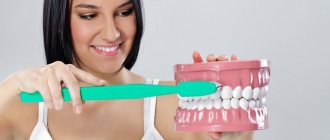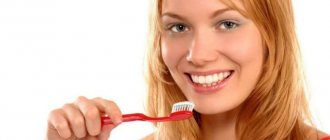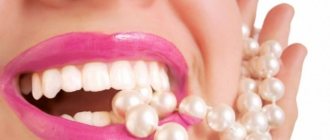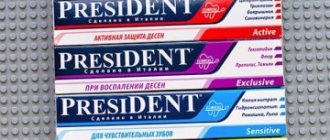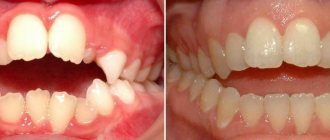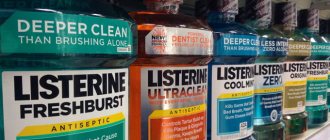Content:
- The importance of choosing the right medicine
- Conditions that must be met by high-quality compositions 2.1. Iodine preparations 2.2. Chlorine 2.3. Preparations based on hexethidine
- For what purpose is it used?
- Indications for use
- How to rinse your mouth correctly
For various dental diseases, doctors often prescribe oral antiseptics.
They reduce the severity of painful symptoms, wash away pathogens from mucous membranes, and improve local blood circulation. With their help, it is possible to slow down the spread of microbial flora and speed up regeneration reactions. of mouth antiseptics on the market , but this does not mean that all of them are safe and effective. During treatment, it is necessary to use exactly the product prescribed by the dentist. Self-selection of medications often makes therapy ineffective or creates conditions for relapse of infection.
Folk remedies
The most famous homemade antiseptic recipe is a soda-salt solution. So, take ½ tsp. each powder, diluted in a glass of warm water, used for rinsing. This is a safe and affordable composition that relieves inflammation, copes with hyperemia and swelling, and has a detrimental effect on pathogenic microorganisms. Rinsing your mouth with soda and salt is recommended for colds, sore throat, tonsillitis, stomatitis and toothache of various etiologies.
Important! If there are ulcers or purulent discharge, the solution is enriched with 3-4 drops of iodine.
At home, you can easily prepare an effective antiseptic composition yourself. To do this, it is enough to stock up on dry plant materials. As a rule, 2-3 tbsp is enough. l. herbs per glass of boiling water. The resulting product is left to infuse for 2–3 hours, after being wrapped in a blanket or poured into a thermos. The finished infusion is carefully filtered, cooled, and used for medicinal rinses.
It is not recommended to prepare alcohol tinctures for treating the oral cavity - such medications can cause burns to the mucous membrane. Moreover, before using pharmaceutical compositions containing alcohol for rinsing, they must first be diluted with water (the proportions are usually indicated on the packaging or indicated by the attending physician).
Which herbs have the most pronounced antiseptic properties:
- chamomile;
- liquorice root;
- plantain leaves;
- yarrow;
- calendula flowers;
- sage.
How else can you disinfect the mucous membranes of the mouth and throat at home? Add a few drops of bergamot or clove oil to warm water and rinse for 2-3 minutes. The oil can be applied directly to the gums or left for a while. Esters have analgesic, anti-inflammatory, and antiseptic properties. You can brew a tea bag, cool, apply to the inflamed area, and leave for 10-15 minutes. The tea will soothe the mucous membranes, as its leaves contain tannic acid.
Saline solution (1 tsp per glass of warm water) is the most affordable home antiseptic
For inflamed gums, it is best to rinse your mouth with peppermint oil diluted in a glass of warm water (a few drops). This solution relieves pain, disinfects soft tissues, and stops the further development of the pathological process.
The importance of choosing the right medicine
It is impossible to completely destroy microorganisms living in the human mouth. But when treating some diseases and conditions, it is necessary to temporarily reduce their number for a short time. Modern antiseptics help a lot with this.
It should be understood that those solutions that are used to treat the skin should not be taken by mouth. Firstly, it is fraught with poisoning. All sanitizers for external use are not intended for oral use.
Secondly, such therapy is always pointless. This is explained by the fact that the human mouth is inhabited by bacteria. Unsuitable products are inactivated by salivary proteins. This means that they do not work on the mucous membranes of the tongue and gums.
Conditions that quality compounds must satisfy
Good developments used by dentists for aseptic purposes must meet a number of requirements:
- exhibit high activity against fungi, viruses, bacteria;
- provide a reliable clinical effect when used in low concentrations;
- in the case of systemic absorption, do not have a pronounced negative effect on the body or internal organs;
- be characterized by a minimal risk of synthesization;
- do not cause poisoning if used in the dosages established by the manufacturer;
- have a neutral smell and taste.
Among the most popular medications that meet these requirements:
- made from iodine;
- including chlorine;
- containing hexetidine.
Let's look at each type of mouth antiseptic in more detail.
Iodine preparations
Iodine is a substance that exhibits pronounced antiseptic properties. It destroys many fungi and microbes and acts as an effective antiprotozoal. Relieves pain, deodorizes, helps to quickly stop bleeding. They are allowed to cauterize wounds.
When treating mucous membranes, undiluted iodine is not used - it must be diluted in the required proportion. Otherwise, you can get a burn to the delicate membranes, which will take a long time to heal.
Iodine must not be combined with alkali, mercury, enzymes, or oxidizing agents. It is also pharmacologically incompatible with ammonia and ethers.
Chlorine
The most prominent representative of the chlorine-containing group is chlorhexidine, a biguanide derivative. It oxidizes and chlorinates proteins, causing their denaturation. As a result, a pronounced deodorizing and antiseptic effect is ensured, pathogenic tissues are destroyed.
Chlorhexidine is found in many oral antiseptics. It is even included in preventive toothpastes. It destroys gram-negative and gram-positive bacteria, fungi, anaerobes, herpes, facultative aerobes. With regular use, the content of pathogenic microorganisms in saliva is reduced by approximately 80-90%. As a result, the rate of plaque deposition is reduced and stone prevention is ensured.
The therapeutic effect of chlorhexidine is explained by the interaction of its positively charged molecules with negative groups of molecules in the bacterial cell wall. The component quickly penetrates the inflammatory focus, reaches the cytoplasmic layers of the microorganism and kills it.
Interestingly, the product is selectively absorbed onto enamel hydroxyapatite . This means that it does not allow bacteria to multiply on the surface of the dental crown. Since it binds tightly to proteins, the therapeutic effect is prolonged - the release of antiseptic substances occurs gradually.
In addition to antibacterial activity, chlorhexidine also exhibits a weak analgesic effect. It is important to remember that its use on an ongoing basis leads to dysbacteriosis. Therefore, there is no need to use chlorhexidine-containing drugs on an ongoing basis.
Do not combine the additive with soap, alkalis, or anionic detergents. It should be taken into account that it increases the sensitivity of the human body to chloramphenicol, cephalosporins, and aminoglycosides.
Preparations based on hexethidine
Hexethidine is a cell membrane destroyer. It accelerates the death of pathogenic organisms and disrupts the synthesis processes necessary for the spread of pathogenic flora. The antifungal activity of the drug is associated with its ability to interfere with the formation of compounds necessary for the formation of the fungal membrane.
It has been established that hexetidine is effective in pathologies caused by:
- mushrooms of the genus Candida;
- Proteus;
- Pseudomonas aeruginosa.
Medicines containing the component relieve pain, stop the spread of inflammation, deodorize and envelop wounds. They help with candidiasis, stomatitis, glossitis, periodontal disease, aphthae, and increased bleeding of the gums. Hexethidine is allowed to treat microtraumas and purulent-inflammatory areas. It is also used in the antiseptic treatment of root canals in the treatment of periodontitis and pulpitis.
Varieties
All solutions intended for mouth rinsing can be divided into several functional groups:
Antibiotics for stomatitis
- anti-inflammatory;
- antiseptic;
- painkillers;
- deodorizing;
- wound healing.
Most modern products sold in pharmacies are combined. Antiseptics can be synthetic and natural, made from plant components. In case of viral infection, dentists prescribe medications that, in addition to antibacterial properties, also have immunomodulatory and antiviral properties.
The most popular means: Interferon, Viferon, Laferobion. For oral candidiasis, Trypsin, Clotrimazole, Vitaon are recommended. To simply disinfect the oral cavity, use:
- Chlorophyllipt.
- Aekol.
- Hexoral.
- Iodinol.
The properties and features of the use of these products are described in more detail below.
For what purpose is it used?
Antiseptic solutions, gels and ointments are used for dental pathologies that require an integrated approach. They allow you to quickly stop the inflammatory process, efficiently cleanse the mucous membranes of infectious agents, and reduce pain in the teeth and gums. Their use is relevant during the recovery period after dental surgery (including the removal of a diseased tooth), to relieve swelling, and eliminate foul odor.
It should be remembered that drugs of this group can cause negative side reactions. So, sometimes instead of the long-awaited recovery, patients receive:
- tissue irritation;
- itching;
- peeling;
- increased sensitivity of the gums.
If such negative symptoms appear, you should stop treatment and get a second dental consultation . It is possible that the disorder was caused by other drugs that the patient applied to the tissue in parallel with the disinfectant medication. Therefore, it is advisable to immediately clarify the situation.
Oral Care Tips
We have collected the top 5 tips from dentists that must be followed to keep your teeth beautiful and healthy.
- Don't go to bed with unclean teeth. Otherwise, the microbes will secrete lactic acid, which causes caries.
- Learn proper teeth brushing techniques. For example, clean them with smooth circular movements without strong pressure, hold the brush at an angle of 45 degrees, treat not only the outer, but also the inner and chewing surfaces of the teeth.
- Clean your tongue at the end of each brushing of your teeth, as plaque, consisting of dead mucous cells, food particles and microorganisms, is regularly deposited on it.
- Eat more fruits and vegetables. Plant foods contain dietary fiber that helps remove plaque from your teeth and tongue. In addition, fruits are excellent sources of vitamins to maintain oral health.
- Limit your consumption of starchy and sweet foods. The fast carbohydrates they contain stimulate the growth of cariogenic bacteria.
Indications for use
Each medicine has its own indications for use. Among the common diseases that are successfully treated with the described dental medications are:
- stomatitis;
- tonsillitis;
- angina;
- periodontal disease;
- periodontitis;
- gingivitis;
- ulcers;
- period of gum recovery after tooth extraction.
Medicines reduce the risk of infection and speed up healing if bacteria have entered the wound. But in order to get positive dynamics with their help, you must strictly follow all medical prescriptions and rinse regularly.
How to rinse your mouth correctly
In many ways, the results of the procedure are determined by the correctness of its implementation. These are the basic rules that dentists are asked to adhere to:
- Regularity. There is no point in rinsing your teeth and gums only when the urge arises. If the dentist says to use the solution every few hours, that’s what you should do. Otherwise, it will not be possible to achieve positive dynamics.
- Under no circumstances should the prepared medicine The optimal temperature is 36-40 degrees Celsius. If a hotter liquid is used, the affected area will heat up, and high temperatures are known to create suitable conditions for the further spread of pathogenic organisms.
- Do not swallow antiseptic. Most of the drugs in the group presented on the pharmaceutical market are not intended for internal use. They negatively affect the functioning of the gastrointestinal tract.
- You don’t just need to take the solution into your mouth and immediately spit it out, but hold it in the area of the affected tissue for about a minute. Such mouth baths are considered the most effective.
Using antiseptics wisely and giving preference to proven means, you can significantly bring recovery closer even with advanced dental diseases.
